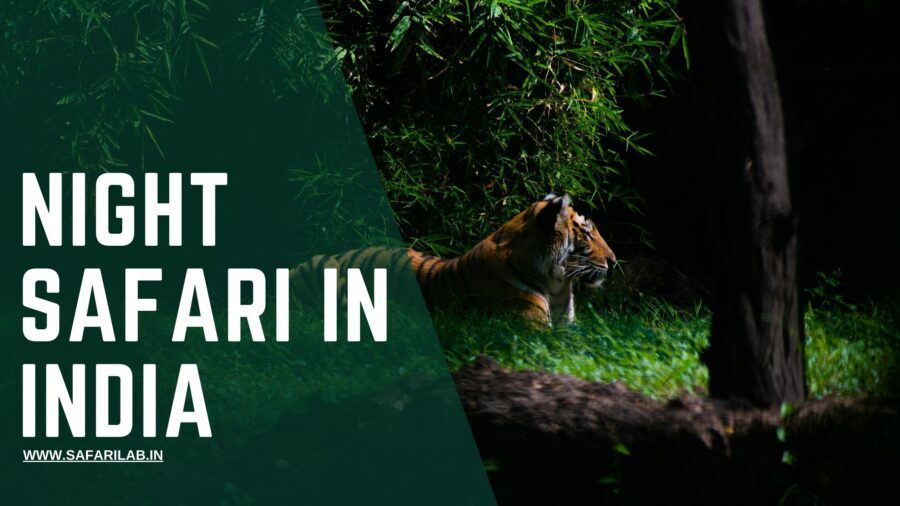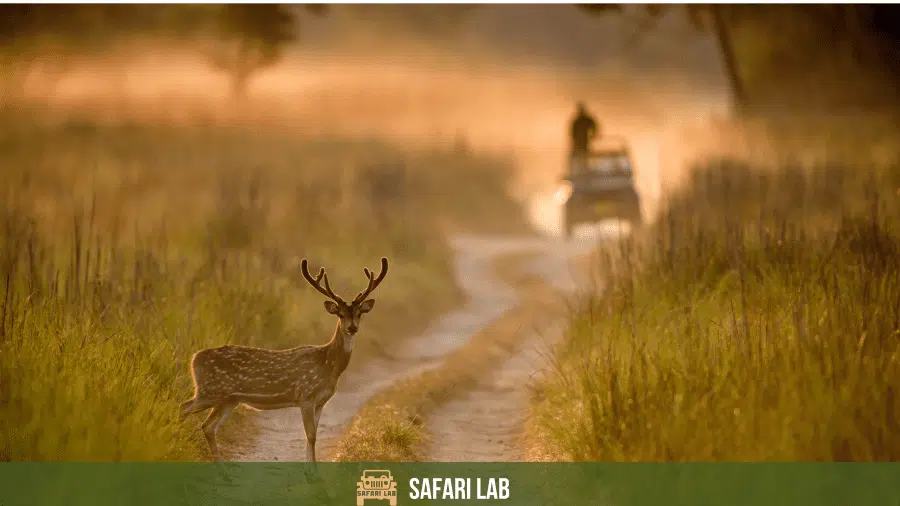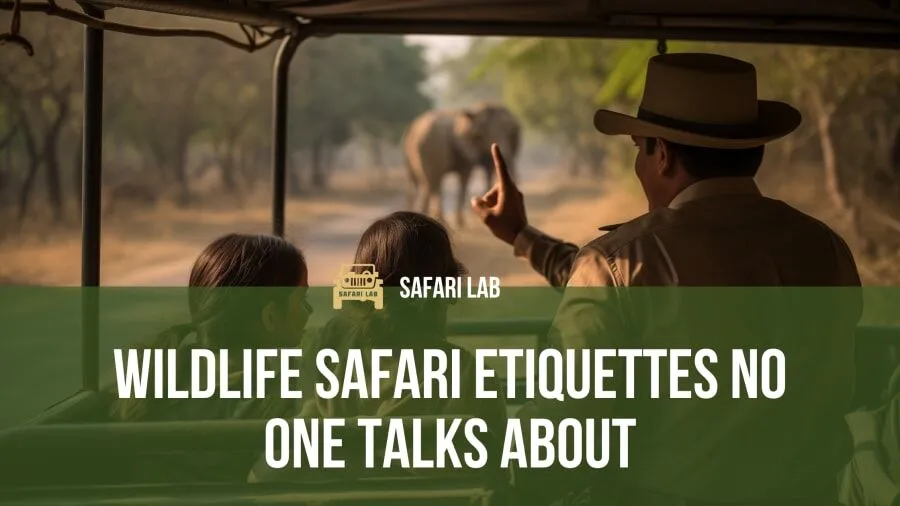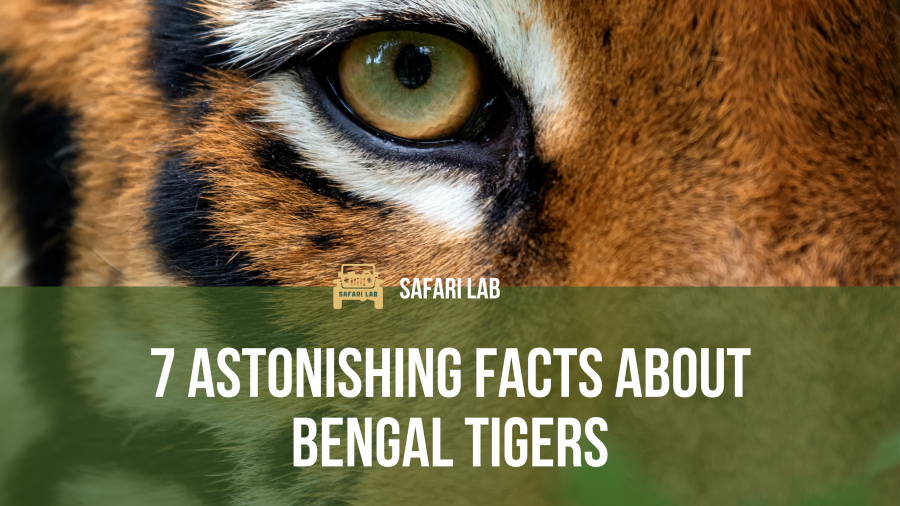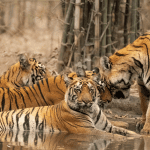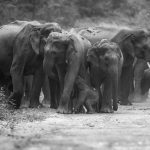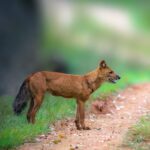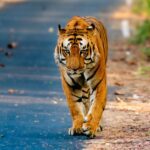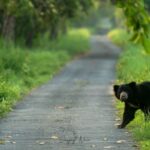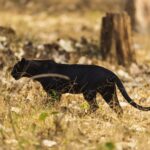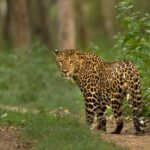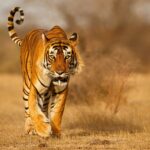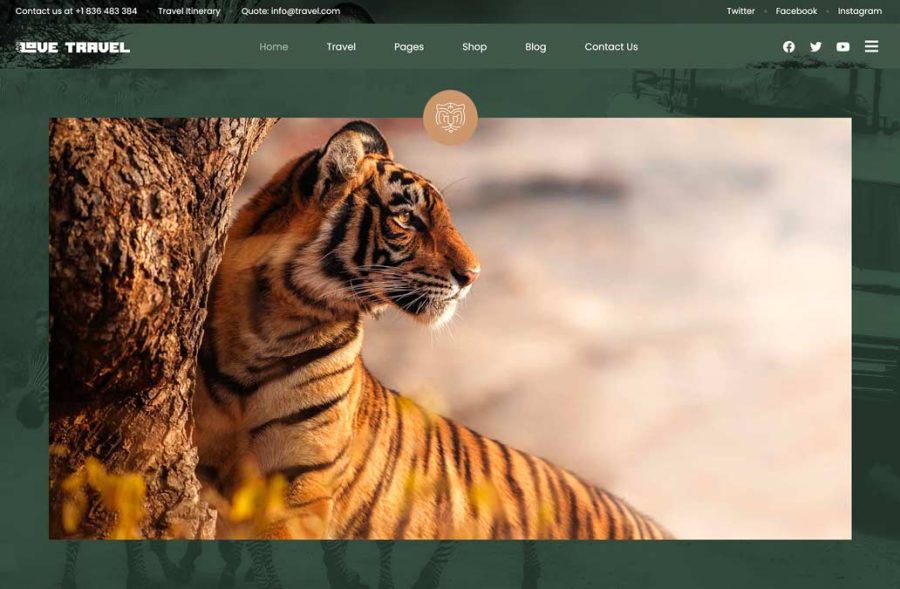If you love wildlife, you’ve probably thought about a night safari in India. As the sun dips below the horizon and darkness unfurls its velvety cloak, the jungle transforms.
The air, thick with the scent of damp earth and wildflowers, hums with unseen life. Crickets orchestrate a rhythmic chorus, an owl calls from the canopy, and somewhere in the undergrowth, a predator stirs.
This is the world of the Indian night safari, where the shadows hold secrets and the wilderness awakens in ways few have witnessed.
What is a Night Safari in India?
Unlike their daytime counterparts, night safaris offer a glimpse into the lives of the forest’s nocturnal inhabitants—creatures that have evolved to thrive in darkness.
With the aid of specialized spotlights, experienced guides navigate buffer zones and forested corridors, revealing the glowing eyes of a leopard on the prowl, the silent passage of a civet, or the ghostly silhouette of an owl in flight.
This is not simply a safari; it is an immersion into an unseen world, one where nature reveals itself in fleeting, spectral moments.
Why Are Night Safaris Popular?
There is an undeniable thrill in venturing into the wild under the cover of night. Without the sun to illuminate the path, the senses heighten—every rustle in the bushes, every distant call, every fleeting shadow takes on a new significance.
Night safaris offer more than just wildlife sightings; they provide a profoundly different experience of the jungle—one where silence is not empty but alive with whispers of creatures unseen.
Yet, these excursions are not without controversy. The ethics of night safaris remain a subject of debate, with conservationists questioning their impact on wildlife.
Should humans intrude upon the nocturnal world of animals already struggling against habitat loss and encroachment? Are these safaris truly educational, or do they risk disturbing the very creatures they seek to observe?
Before we delve into that debate, let’s first explore where in India one can legally partake in this nocturnal adventure.
A Night Safari in India: Buffer Zones, Not Core Zones
For those eager to experience India’s wild heart after dark, it’s important to understand where night safaris are permitted. Unlike daytime safaris, which operate in the core zones of national parks, night safaris are conducted exclusively in the buffer zones—the transitional areas surrounding the protected core.
This regulation exists to minimize disturbance to wildlife while still allowing visitors a chance to explore the jungle’s nocturnal wonders.
Does it reduce the chances of spotting wildlife? Not really!
On paper, national parks are divided into core and buffer zones—one strictly protected, the other a softer transition between wilderness and human habitation.
But in the jungle, no such lines exist. To the leopard slinking between trees, to the tiger that crosses a road under the cover of darkness, these divisions are meaningless.
In reality, animals move freely between these zones. A buffer today may become a hunting ground tomorrow, and a quiet waterhole in the core may be abandoned as summer dries it up. It is only humans who define these spaces, drawing invisible lines across an ancient, untamed world.
While night safaris are restricted to buffer zones to minimize disturbance, the truth remains: the jungle does not adhere to human rules.
Top Destinations to experience a Night Safari in India
Let’s take a look at some of India’s top destinations for a legal night safari.
Pench National Park, Madhya Pradesh (Khawasa & Rukhad Gates)
A landscape straight out of Kipling’s Jungle Book, Pench’s buffer zones come alive at night. Here, Indian wolves move like phantoms across open grasslands, leopards slink through dry teak forests, and herds of chital freeze at the snap of a twig.
The Rukhad zone, in particular, is a hotspot for big cats, with occasional sightings of the Bengal tiger—a silent, shadowy presence in the darkness. If you come across the dominant male tiger fondly called ‘Bajirao’ during one of the night safaris in India, we assure you it will give you goosebumps.
Kanha National Park, Madhya Pradesh (Khatiya, Mukki & Sijora)
Kanha’s forests, thick with sal and bamboo, are home to some of the richest biodiversity in central India. As night falls, civet cats, porcupines, and even the elusive sloth bear emerge from their hiding places.
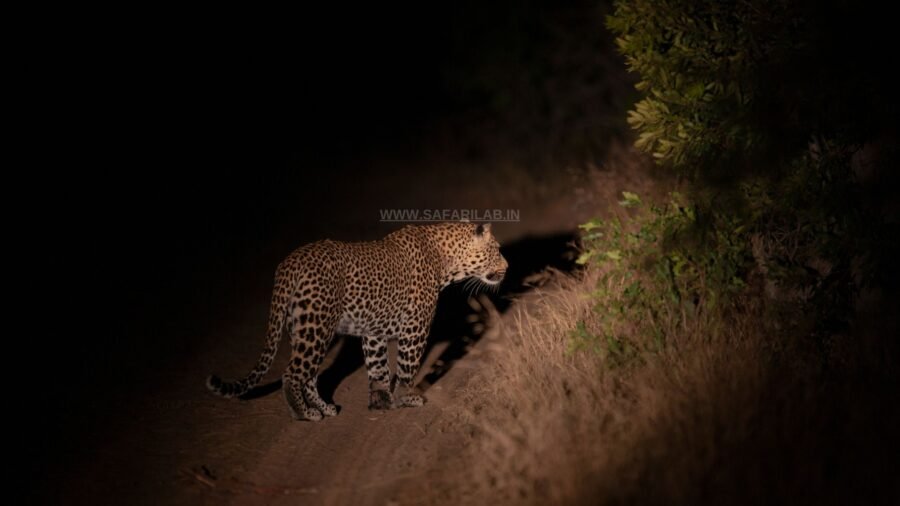
Here too, the tiger roams, unseen but never absent, its territory dictated by instincts older than any boundary drawn on a map.
Bandhavgarh National Park, Madhya Pradesh (Pachpedi (Panpatha) & Dhamokhar (Paras))
Bandhavgarh, with its craggy hills and dense undergrowth, is legendary for its tiger population. In the buffer zones, jackals trot along moonlit trails, while hyenas scavenge for remnants left behind by larger predators.
The presence of the tiger here is felt more than seen—a heavy, invisible force in the night.
Panna Tiger Reserve, Madhya Pradesh (Jhinna Buffer Zone)
Perhaps the most underrated of India’s tiger reserves, Panna offers a true wilderness experience.
Crested serpent eagles scan the ground from their perches, rusty-spotted cats—one of the world’s smallest wild cats—dart across trails, and sambar deer let out deep alarm calls, signaling an unseen predator’s approach.
It is one of the few places where, under the right conditions, a tiger may be glimpsed crossing the safari track in the dead of night.
The Unofficial Night Safaris in India: A Grey Zone of the Wild
Beyond the regulated boundaries of national parks, a different kind of night safari unfolds—one that exists in a legal and ethical grey area.
Across India’s forested landscapes, private resorts and local operators offer “night safaris” that do not technically enter protected areas but still provide a nocturnal wildlife experience.
These excursions take place on public roads, highways cutting through dense forests, and village tracks skirting the edges of national parks, where wildlife often wanders freely under the cover of darkness.
How does an Unofficial Night Safari in India Work?
Unlike official safaris, which are regulated by the forest department and require permits, these night drives often involve privately owned jeeps, resort vehicles, or even motorcycles weaving through forested corridors and buffer zones.
Operators use powerful flashlights or high-beam headlights to scan for glowing eyes in the undergrowth, offering tourists a chance to glimpse creatures that remain elusive during the day.
Some of the most well-known locations where such unofficial safaris occur include:
Night Safari in Wayanad, Kerala
Night drives along the Bavali–Mananthavady road and through the Tholpetty stretch are particularly popular. Here, elephants, leopards, and even tigers have been sighted crossing the road under the cover of darkness.
Bandipur-Mudumalai Highway (NH 181), Karnataka-Tamil Nadu
This infamous stretch cuts through prime elephant and leopard habitat. While technically a public road, it is notorious for night-time wildlife sightings.
Ranthambhore, Rajasthan
Some resorts bordering the park offer “night excursions” along village roads where striped hyenas, leopards, and jungle cats are frequently sighted.
Jim Corbett (Sitabani Stretch)
While regular patrolling and spot fines deter resort owners from conducting night drives along the main stretch of highway near Bijrani and Dhikala zones of Corbett, the Sitabani stretch often has resorts conducting unofficial night safaris in India.
Ethical Dilemmas & Dangers of Illegal Night Safaris in India
Unofficial night safaris might promise thrilling encounters, but they come at a cost—often to the very animals they seek to showcase.
- Disturbance to Wildlife – High beams and flashlights disorient animals, especially nocturnal hunters like leopards and owls that rely on darkness for survival.
- Increased Roadkill Risk – Forest roads are lifelines for wildlife movement, and vehicles speeding through them at night lead to frequent accidents involving deer, civets, and even big cats.
- Poaching & Illegal Activities – Some unscrupulous operators use these night drives as a cover for hunting or illegal trade in wildlife products, especially in remote areas where enforcement is lax.
A Responsible Alternative
While the lure of an unregulated night safari is strong, ethical wildlife tourism must prioritize conservation over spectacle.
If you’re keen on experiencing the nocturnal jungle, opt for authorized night safaris in designated buffer zones, where strict guidelines ensure minimal disruption to the ecosystem.
The true magic of the wild lies not in artificial encounters but in moments of genuine, untamed wonder.
What Wildlife Can You Expect to See on a Night Safari in India?
As darkness settles over the jungle, the cast of characters changes. The sun-loving herbivores retreat into the shadows, while the true masters of the night emerge. These are creatures built for darkness—silent, spectral, and often unseen by those who visit only in daylight.
The Big Cats: Stealth in the Shadows
- Bengal Tiger – Though tigers are more active at dawn and dusk, they do move at night, especially in buffer zones where human presence is minimal. A distant chital alarm call, a rustling in the dry leaves, and if you’re lucky—briefly, unmistakably—a tiger melts into the darkness.
- Leopard – The true ruler of the night. Unlike tigers, leopards thrive in darkness, using it as an ally to stalk prey. Often, the only sign of their presence is a fleeting pair of glowing eyes in a treetop or a shadow slipping silently across the road.
- Jungle Cat & Rusty-Spotted Cat – These small, elusive small wild cats prowl along forest edges and open grasslands, their night vision far superior to anything human eyes can manage.
The Nocturnal Hunters: Eyes That Glow in the Dark
- Striped Hyena – Solitary, ghostly figures that scavenge on the edges of villages and forests, their eerie whooping calls often the only sign of their presence.
- Indian Wolf – Rare and highly elusive, wolves prefer open grasslands but can be spotted prowling buffer zones, hunting in small packs under the cover of darkness.
- Civet Cats & Palm Civets – Slipping between branches like shadows, these small carnivores are adept climbers and expert hunters of rodents and birds.
The Silent Stalkers of the Forest Floor
- Sloth Bear – Surprisingly aggressive when startled, sloth bears roam at night, their long claws designed for ripping apart termite mounds rather than flesh—though they have been known to attack when disturbed.
- Porcupine – A rare but fascinating sight, these spiky rodents shuffle through the undergrowth, their quills rattling as a warning to predators.
- Jackals & Foxes – Agile and opportunistic, they trot along forest paths and village roads, scavenging for scraps and hunting small prey.
The Avian Night Watchers
- Owls & Nightjars – From the deep, resonant call of the Indian eagle owl to the soft, almost whisper-like flight of the nightjar, these birds dominate the night sky.
- Frogmouths – Masters of camouflage, frogmouths sit motionless on branches, almost indistinguishable from the tree bark itself.
Reptiles, Amphibians, and Insects
- Snakes – Russell’s vipers and kraits become active after sundown, gliding through leaf litter in search of unsuspecting prey.
- Tree Frogs & Toads – The monsoon months bring a deafening symphony of croaks, as countless amphibians emerge from their hiding places.
- Fireflies – In certain seasons, entire forests light up with their glow, a mesmerizing dance of bioluminescence in the pitch-black jungle.
The True Essence of a Night Safari
Unlike daytime safaris, where animals are often seen in full view, a night safari is an experience of fragments—flashes of movement, glowing eyes in the distance, the sound of something unseen rustling past your vehicle. It is an adventure not just of sight, but of sound and imagination.
Dos and Don’ts: How to Experience a Night Safari Responsibly
A night safari is not just about what you see—it’s about how you see it. The jungle after dark is a delicate, living entity, and a careless visitor can cause more harm than they realize. Here’s how to ensure that your after-dark adventure respects the wilderness and its inhabitants.
✅ Dos: The Right Way to Explore the Night
✔ Follow the Rules & Stick to Designated Routes
- Official night safaris are conducted only in buffer zones to minimize disturbance. Stay within these boundaries, as venturing into restricted areas is both illegal and disruptive to wildlife.
✔ Use Red or Dimmed Lights for Viewing
- Many nocturnal creatures, including big cats and owls, have eyes adapted to darkness. Bright white lights can temporarily blind and disorient them. Ethical guides use soft red or amber filters on their torches to reduce impact.
✔ Maintain Silence & Listen to the Jungle
- The thrill of a night safari lies as much in the sounds of the forest as in the sights. The rustle of a predator in the undergrowth, the distant alarm call of a spotted deer—these are nature’s own clues to unseen activity.
✔ Be Patient & Observe the Little Things
- Unlike daytime safaris, where sightings are often more obvious, night safaris reward those who watch closely. A fleeting shadow in the trees, a small movement in the grass—sometimes, the most magical moments come in whispers.
✔ Wear Dark, Non-Reflective Clothing
- Avoid bright colors or anything that reflects light, as this can startle animals. Neutral, earth-toned clothing is ideal.
✔ Respect the Guide’s Instructions
- Your guide is not just a navigator but a guardian of the jungle. If they ask you to lower your voice, dim your light, or stay still, trust their instincts.
❌ Don’ts: What NOT to Do on a Night Safari
❌ No Flash Photography or Blinding Lights
- A sudden burst of flash can startle animals, disrupt hunting behavior, and even trigger defensive aggression. If photography is allowed, use a high ISO setting and no flash.
❌ Do Not Play Animal Calls or Use Baiting Techniques
- Some unethical operators play recorded calls of tigers, leopards, or deer to lure animals closer. This confuses and distresses wildlife, disrupting their natural communication and territory marking.
❌ Never Get Out of the Vehicle
- It may seem tempting to step out for a better view, but predators are most active at night—and often closer than you realize.
❌ No Sudden Movements or Loud Talking
- Predators hunt by stealth, and prey rely on silence to detect danger. A sudden yell, a loud laugh, or unnecessary movement can send animals fleeing or, worse, provoke an aggressive response.
❌ Do Not Litter or Leave Food Behind
- Food waste attracts scavengers like hyenas and jackals to areas with human activity, disrupting their natural foraging patterns and making them dependent on human settlements.
A Night Safari is a Privilege, Not a Right
To witness the jungle at night is to enter a world where humans are not in control. We are merely visitors, passing through realms where stealth is survival, silence is communication, and the darkness belongs to those who have mastered it.
Frequently Asked Questions: Night Safaris in India
Night safaris are still a relatively new concept in India, and with that comes curiosity, misconceptions, and a fair amount of confusion about where they are officially conducted. Here are some of the most commonly asked questions:
Is there a night Tiger safari in Tadoba?
No, Tadoba-Andhari Tiger Reserve does not conduct official night safaris. All safaris in Tadoba, including buffer zone safaris, operate only during designated daytime slots.
However, visitors often mistake night drives on public roads near Tadoba as “night safaris.” Certain roads, like the Chimur-Moharli highway, pass through tiger corridors, and nocturnal animals are sometimes seen crossing them. But these are not sanctioned safaris—they are merely wildlife encounters on public roads.
Is there a night safari in Jim Corbett National Park?
No, night safaris are not allowed inside Corbett Tiger Reserve. The forest department strictly prohibits any tourist movement after sunset to minimize disturbance to wildlife.
That said, some resorts along the park’s periphery offer “night safaris” on roads bordering the reserve, especially in the Sitabani buffer zone. While these drives sometimes yield sightings of leopards, elephants, and jungle cats, they are not official wildlife excursions.
Are night safaris safe?
Yes, when conducted by licensed operators in designated buffer zones, night safaris are safe. The guides are trained to handle encounters with wildlife, and vehicles are required to follow strict safety protocols.
However, unofficial night drives can be risky, especially on roads where wild animals may react unpredictably to vehicle lights or sudden movement.
What is the best time of year for a night safari?
- Winter (November – February): The cold season offers clear skies, fewer insects, and excellent chances of spotting big cats and other mammals that are more active in the cool air.
- Summer (March – June): The dry months force animals to congregate near water sources, increasing the likelihood of sightings. However, temperatures can be extreme.
Which national park offers the best chance of spotting big cats on a night safari?
Pench and Bandhavgarh buffer zones have reported frequent sightings of leopards and occasional tigers on night safaris. Kanha and Panna also offer strong possibilities, though sightings are always a matter of chance.
Are night safaris suitable for children?
Yes, but only for children above a certain age (usually 8–10 years old). Young children may struggle with long hours of sitting in silence and can unintentionally disturb wildlife with sudden movements or noise
How much does a night safari cost?
Costs vary by park and operator, but generally, an official night safari costs ₹3,500 – ₹7,000 per jeep (which can accommodate 4–6 people). Luxury safari lodges may charge significantly more for a private experience.
The Final Word: The Jungle Belongs to the Night
A night safari is not just about what you see—it’s about what you feel. The thrill of the unknown, the rustling in the darkness, the sound of an animal moving just beyond the reach of your flashlight. To witness the wilderness at night is to step into a world where humans are no longer in control.
For those who seek an adventure beyond the ordinary, a night safari—done responsibly, with respect for the creatures that call the darkness home—offers a glimpse into nature’s most mysterious realm.

